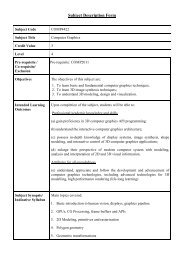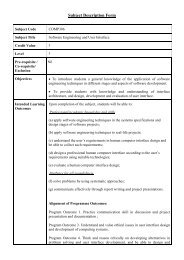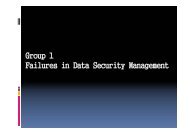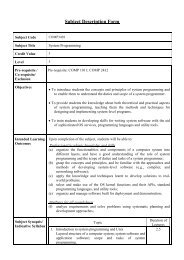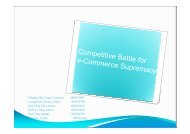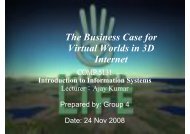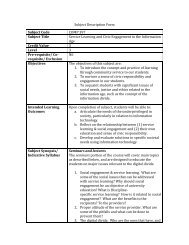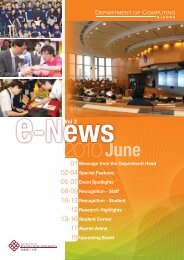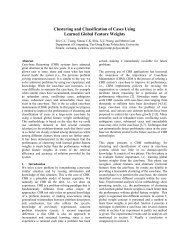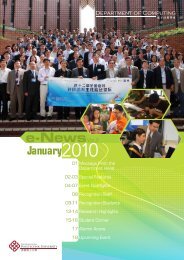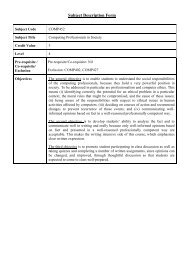COMP324 Project Methodology and Implementation
COMP324 Project Methodology and Implementation
COMP324 Project Methodology and Implementation
You also want an ePaper? Increase the reach of your titles
YUMPU automatically turns print PDFs into web optimized ePapers that Google loves.
Subject Description FormSubject CodeSubject Title<strong>COMP324</strong><strong>Project</strong> <strong>Methodology</strong> <strong>and</strong> <strong>Implementation</strong>Credit Value 3Level 3Pre-requisite /Co-requisite/ExclusionPre-requisite: COMP302, COMP311Co-requisite: NilExclusion: COMP322ObjectivesIntended LearningOutcomes• To teach students the techniques of using dynamic scripting languages.• To deliver the methods of using dynamic scripting languages for solving varioustasks in enterprise application integration.• To deliver project management theory, principle <strong>and</strong> stages.Upon completion of the subject, students will be able to:Professional/academic knowledge <strong>and</strong> skills(a) underst<strong>and</strong> the basic components of an enterprise system architecture;(b) underst<strong>and</strong> the problems <strong>and</strong> issues encountered in enterprise applicationintegration;(c) use a dynamic scripting language, namely Ruby, to solve various tasks inenterprise application integration;(d) gain knowledge <strong>and</strong> h<strong>and</strong>s-on experience (through a course project) in planning,organizing, <strong>and</strong> managing large projects.Attributes for all-roundedness(e) enhance the problem solving skill, team working skills, technical report writing<strong>and</strong> presentation skill through the group project.Alignment of Programme Outcomes:Programme Outcome 1: This subject contributes to having students practice theirwriting skills with project document <strong>and</strong> report writing.Programme Outcome 3: This subject contributes to developing student underst<strong>and</strong>ing<strong>and</strong> valuing ethical issues in developing information systems through tutorials <strong>and</strong>working on project <strong>and</strong> assignments.Programme Outcome 5: This subject contributes to problem solving with Ruby <strong>and</strong>other programming skills through lab exercise <strong>and</strong> project with proper design <strong>and</strong>implementation.Programme Outcome 7: This subject contributes to team work with group-basedproject for students to practice team spirit.
Subject Synopsis/Indicative SyllabusTopic1. Introduction to enterprise application integrationBasic components of an enterprise system architecture; problems<strong>and</strong> issues in enterprise application integration; common tasks inenterprise application integration; advantages of using dynamicscripting languages for enterprise application integration.2. Introduction to Ruby programmingObject-oriented programming in Ruby; basic features of Ruby;Arrays <strong>and</strong> Hashes; Blocks <strong>and</strong> Iterators.3. Integrating databasesIntegrating heterogeneous databases; Ruby’s database interface(DBI); ActiveRecord: object-relational mappers.4. Processing XML with RubyGenerating, processing, <strong>and</strong> validating XML.5. Distributed applications in RubyIntegration using HTTP; remote procedure call (RPC) in Ruby;talking to web services;6. <strong>Project</strong> Management<strong>Project</strong> scheduling, critical path method, software project riskmanagement, PERT evaluation of uncertainty, critical chainapproach, managing people in virtual projects, ethical <strong>and</strong> legalissues.DurationofLectures2.57.57.5557.5Total 35Laboratory Experiment:TopicDuration ofLaboratory1. Ruby programming exercises 6Total 6Tutorial:1. <strong>Project</strong> management skills2. Group projectTopicDuration ofTutorial44Total 8Teaching/Learning<strong>Methodology</strong><strong>Project</strong> planning <strong>and</strong> management techniques <strong>and</strong> the different enterprise applicationintegration technologies will be covered in the lectures. In the tutorials, students willwork on exercises in software project management <strong>and</strong> project management tools(e.g. Microsoft <strong>Project</strong>). Also, students will develop programming skills required tocomplete the application integration project.
AssessmentMethods inAlignment withIntended LearningOutcomesSpecific assessmentmethods/tasks%weightingIntended subject learning outcomes to beassessed (Please tick as appropriate)a b c d e1. Assignments 2. <strong>Project</strong> 3. Mid-term 70% 4. Examination 30% Total 100 %Explanation of the appropriateness of the assessment methods in assessing the intendedlearning outcomes:Students are required to work as a team to complete an integration project. The project can beused to assess the students on their ability to (c) solve various problems in enterpriseapplication integration <strong>and</strong> (d) gain knowledge <strong>and</strong> h<strong>and</strong>s-on experience (through a courseproject) in planning, organizing, <strong>and</strong> managing large projects. Also, the group project can (e)enhance the students’ problem solving skills, team working skills, technical report writing<strong>and</strong> presentation skills.Assignment(s), mid-term(s) <strong>and</strong> the final examination will be used to assess the students ontheir (a) underst<strong>and</strong>ing in the basic components of an enterprise system architecture, (b) theproblems <strong>and</strong> issues encountered in enterprise application integration, <strong>and</strong> (c) their skills inwriting programs to solve various tasks in enterprise application integration.Student StudyEffort RequiredClass contact:• Lecture 35 Hrs.• Laboratory 6 Hrs.• Tutorial 8 Hrs.Other student study effort:• Hrs.• Hrs.Total student study effortAt least 49 Hrs.Reading List <strong>and</strong>ReferencesReferences:1. Hal Fulton. The Ruby Way, Second Edition: Solutions <strong>and</strong> Techniques in RubyProgramming (2nd Edition), Addison-Wesley Professional, 2006.2. Peter Cooper. Beginning Ruby: From Novice to Professional, Second Edition,2009. Apress.3. Huw Collingbourne. The Book of Rudy. Available at
http://www.sapphiresteel.com/The-Book-Of-Ruby as of Apr 21, 2010.4. Kathy Schwalbe. Information Technology <strong>Project</strong> Management (with Microsoft<strong>Project</strong> 2007 CD-ROM), Sixth Edition, 2009. Course Technology.5. Harold Kerzner. <strong>Project</strong> Management: A Systems Approach to Planning,Scheduling, <strong>and</strong> Controlling, 2003. Wiley; 8 edition.6. Andrew Stellman <strong>and</strong> Andrew Stellman. Applied Software <strong>Project</strong> Management,2005. O'Reilly.



